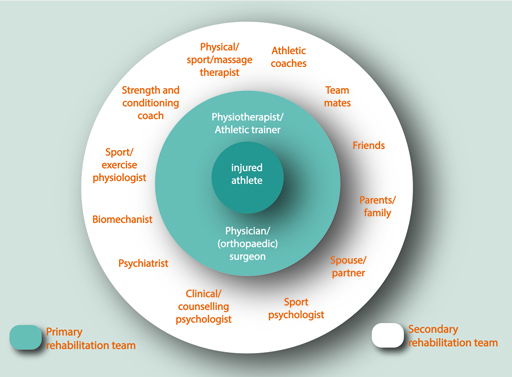2 The team around the injured person
The biopsychosocial approach suggests that those around the injured athlete or exercise participant need to consider the impact of biological, psychological and social factors on the individual, but who exactly are these people? When someone suffers from a sport injury there are potentially a myriad of people who can support and influence the injured person. In the next activity you will try to identify who some of these people are.
Activity 2 The people around the injured athlete/exercise participant
- Make a list of all the people you think might be involved in supporting an injured athlete or an exercise participant in some way. These can be people in formal or informal roles. Try to think beyond just sports medicine professionals.
If you have experienced an injury yourself or are familiar with someone who has experienced an injury, you may find it useful to reflect on who supported you (or them) during the injury. Or you might identify who didn’t support you that you think should have.
- Pick three of the people in your list and try to describe the type of support they provide to the injured person.
Discussion
- There are a wide range of people who can support the injured athlete. The most obvious of these are sports medicine professionals such as physiotherapists, sports therapists and surgeons. Clement and Arvinen-Barrow (2013) call these people the ‘primary rehabilitation team’ (Figure 3). In addition to these people there are various other individuals who might support the injured person in different ways who can be termed the ‘secondary rehabilitation team’ (Clement and Arvinen-Barrow, 2013). The people that make up this secondary team will vary from individual to individual, but can include professionals such as coaches, instructors and sport psychologists, and people in non-professional roles such as family members, team mates and friends. Figure 3 gives more examples of people who might fit into this category.
- We asked our case study Lois to describe the support she gets from three of the people on her list and this is what she said:
Three key people on my list are my physio, my sport psychologist and my boyfriend, Dave. My physio gives the kind of traditional sport injury support in that she treats the physical aspect of my injury, but she also motivates me to get through the rehab sessions which can sometimes be quite painful. My sport psychologist, Amir, helps with the more emotional side of the injury and he also talks to my physio so that they can support me together which is really useful. Finally, my boyfriend is probably one of my biggest sources of support as he’s with me every day and sees my highs and lows and knows what to say to pick me up when I’m feeling down. (Lois, sprinter) |
The activity you’ve just completed shows how different people can provide support to the injured person. Next you’ll explore this further as you examine the multidisciplinary support team.

